Is porridge the ultimate winter breakfast, or a gruel best left in the past? Do you prefer yours basic, austere even, or luxurious?
Moan as we might about winter weather, I believe British spirits secretly soar with each slump of the mercury. Admit it: much though we love to bathe in its rays drinking cider, complaining about the heat and turning quietly lobster-coloured, sunshine doesn't sit well with us. But with the barbecue full of rainwater and the soft fruit safely in the freezer, we can finally throw off the shackles of Greek yoghurt, renounce exotic smoothies, and return thankfully to the scenes of our greatest culinary achievements: the breakfast table.
Kippers and marmalade, laverbread fried in bacon fat, egg sandwiches and black pudding are all fine, upstanding stuff if you're off on a long frosty walk, but less practical on a daily basis if, say, you spend your life pottering around the world wide web. Porridge, however, is the acceptable face of the traditional British breakfast – note I say British, neatly skirting around the fact that according to the Oxford Companion to Food, it descends from that "thoroughly English institution" the medieval pottage – being high in fibre and protein, proven to lower cholesterol and protect against heart disease (in its more austere guises anyway) and, that holy grail of modern living, "low GI".
Kippers and marmalade, laverbread fried in bacon fat, egg sandwiches and black pudding are all fine, upstanding stuff if you're off on a long frosty walk, but less practical on a daily basis if, say, you spend your life pottering around the world wide web. Porridge, however, is the acceptable face of the traditional British breakfast – note I say British, neatly skirting around the fact that according to the Oxford Companion to Food, it descends from that "thoroughly English institution" the medieval pottage – being high in fibre and protein, proven to lower cholesterol and protect against heart disease (in its more austere guises anyway) and, that holy grail of modern living, "low GI".
Not one to be swayed by the whims and fancies of our dear leader, my love of porridge is of a rather longer standing, but until recently, I was a rank amateur at its production. Two things happened to convince me things had to change. Firstly, one taste of the heavenly porridge at Ballymaloe House in County Cork, and secondly, the realisation that I was sick of cleaning oats from the inside of the microwave. Turns out that, although you can make decent porridge in that contraption, to even approach the foothills of perfection, you need to use a pan. People may complain, but if you're not prepared to wash up a saucepan, then you should probably stick to Ready Brek. Which I also secretly love.while for the body to digest, which means it releases its energy more slowly, keeping you feeling fuller for longer. (This last property can also be blamed for the "porridge glow" many people experience when entering crowded public transport in the mornings.) According to the media (ie people like me) it's also pretty fashionable, although I'm not sure David Cameron and Tim Henman are quite the arbiters of style Quaker Oats believes they are.
Notes on oats
Prior to my conversion, I thought there were only two types of oats. The proper kind which rejoice in the comfortingly stout subtitle "jumbo rolled", and instant sawdust. How wrong I was. All the porridge big guns use oatmeal instead – indeed, rolled oat flakes are forbidden in the Golden Spurtle World Porridge Championships (yes, it exists) and Sybil Kapoor pronounces them "tasteless and pappy in the porridge". Chastened, I go back to the books, and acquaint myself with Avena sativa afresh.
According to Catherine Brown's Scottish Regional Food, once the outer husk of the oat has been removed, the kernel (or, more medievally, the groat), can take one of three paths. Either it will be steamed, then rolled into jumbo oat flakes, or it can be cut in half ("pinhead") and then eaten as is or steamed and rolled to make ordinary oat flakes, or it can be ground into coarse, medium or fine oatmeal. Not are the non-steamed oats apparently more nutritious (although Harold McGee disputes this), but, after testing a standard recipe from the Ballymaloe Cookery School bible, they seems to retain a stronger, more distinctive flavour, and a more interesting texture. My normal porridge suddenly seems disappointingly gloopy.
Saying that, I find the pinhead slightly too chewily wholesome on its own, but the medium one brings the inevitable comparison to wallpaper paste, which puts me off trying any fine ground oatmeal. I'm torn – I want my porridge to have some texture, but first thing in the morning is no time for grim chewing. Sue Lawrence, author of a number of books on Scottish cooking (and MasterChef champion 1991, back when they had red kitchens and Loyd Grossman's puzzling vowels), uses a mixture of the two, and once I've adjusted her ratio to include a bit more nubbly, nutty pinhead, I feel I've done the oat question justice.
Liquid
Scottish traditionalists insist that porridge should contain nothing more than oats, water and salt, but such an attitude strikes me as depressingly dour: after all, if no one had ever experimented, then we'd still be eating be eating pease pottage, morning, noon and night. Full-fat milk makes a delicious, but queasily rich breakfast, but, even allowing for the time-honoured creamy moat of milk at the end, porridge made with water only has a Puritan thinness of flavour. After a bit of juggling, I settle for a 1:2 ratio of milk to water.
Michelin-starred chef Tom Kitchin uses a 1:2 ratio of oats to liquid, while Edinburgh's Balmoral Hotel opts for a more generous 1:4, and cooks them for about 5 times as long. I find Tom's become gluey before they're cooked through, and the Balmoral version too loose – Ballymaloe's 1:3 works perfectly for me.
Method
You can soak your oats overnight to speed up the cooking time – oatmeal, particularly pinhead oatmeal, takes longer to cook than the ready-steamed, rolled flakes. Simon Humphreys, who came third in the Golden Spurtle in 2007, reckons that soaking is "an absolute must to ensure the perfect consistency" but I'm not convinced, after testing, that it makes much difference. If you remember the night before, however, it may save you 5 minutes the next morning.
Anna Louise Batchelor, winner in the 2009 "speciality" category of the Golden Spurtle, with her Spotted Dick Porridge Pudding, makes her porridge in a bain marie, or porringer, which prevents it from sticking to the bottom of the pan, and means that the oats cook more slowly, which apparently gives them more flavour. This surprises me because, with the frequent stirring advocated by Sue Lawrence and Ballymaloe's Darina Allen, I haven't had any problems with them catching, but I give it a try anyway. It takes such a long time to cook that I'm ill-disposed towards it from the start, but even so, I'm prepared to swear there's no difference to the flavour.
One thing that does noticeably improve the taste of my porridge, however, is toasting the oats, as one would when making the Scottish pudding, cranachan, before cooking them. It only takes a couple of minutes, and gives the finished dish a distinctly nutty, roasted flavour.
F Marian McNeill, author of the 1929 classic, The Scots Kitchen, advises that the oats should be sprinkled over boiling water, "in a steady rain from the left hand, stirring it briskly the while with the right, sunwise" rather than heated with the water in the pan. Darina Allen agrees, but, having tested this out, it seems to make no more sense than the idea that stirring them anti-clockwise will encourage the devil into your breakfast.
Jeff Bland, the executive chef at the Balmoral, claims that "one of the most important things is once the porridge is cooked, to turn off the hob, put a lid on it, and just let it sit there for 10-15 minutes". He's right, although, for a smaller quantity of porridge, I think five or so is sufficient – not only is the porridge just cool enough to eat, but it seems to have developed a bit more flavour in the meantime.
Flavourings
Salt is a must in porridge, whether you plan to get all Sassenach with the sugar later or not. Nigel Slater claims that if you add it too early, it toughens the oats, which makes sense: the same applies to beans, but Dorothy Hartley's 1954 Food in England directs one to add the oats to ready-salted water. With all that pinhead oatmeal, I'm not sure I can detect any difference in texture, but adding the salt later, when much of the liquid has evaporated, allows me to better judge how much I'll need. If you stir it in the right before serving, however, it seems to get lost: towards the end of cooking is ideal.
Toppings are very personal – I like the crunch of demerara sugar, or the gooey sweetness of golden syrup, but Gordon Ramsay "keeps it real" with Greek yoghurt and honey, and Barry Gauld of the Kinlochewe Hotel, Achnasheen goes for langoustine tails and scallops.
A girdle of very cold milk, or single cream on special occasions, is essential, (traditionally, it would be served in a separate bowl, to keep the oats hot and the milk cold), but a knob of butter, as suggested by Word of Mouth readers, while melting attractively into the oats, proves too greasy for my taste.
Perfect porridge
The important thing is that porridge should be creamy in texture (lots of stirring required), but with enough chewy bite to keep it interesting. Toasting brings out the flavour of the oats, and a little milk gives it a silky richness that would horrify puritans north of the border – the sugar situation, however, is up to your conscience.
Per person
¼ cup pinhead oatmeal (about 25g)
¼ cup medium oatmeal (about 25g)
½ cup (about 100ml) whole milk
1 cup (about 200ml) water
Generous pinch of salt
Demerara sugar, golden syrup, chopped dates etc
A little more cold milk, to serve
¼ cup medium oatmeal (about 25g)
½ cup (about 100ml) whole milk
1 cup (about 200ml) water
Generous pinch of salt
Demerara sugar, golden syrup, chopped dates etc
A little more cold milk, to serve
1. Heat a dry frying pan over a medium high heat and toast the oats until fragrant. Put the oats in a medium saucepan along with the milk and 1 cup (about 200ml) water and bring slowly to the boil, stirring frequently with a spurtle, or the handle of a wooden spoon.
2. Turn down the heat even further, and simmer, stirring very regularly, for about 10 minutes, until you have the consistency you require. After about 5 minutes, add the salt.
3. Cover and allow to sit for 5 minutes, then serve with the toppings of your choice and a moat of cold milk.
Is porridge the ultimate winter breakfast, or a gruel best left in the past? Do you prefer yours basic, austere even, or luxurious – and can anyone suggest some good savoury recipes to rival a Chinese congee?

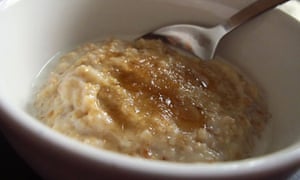
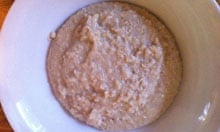
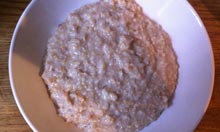
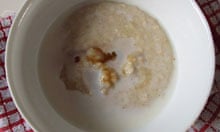
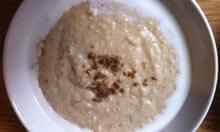
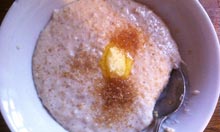
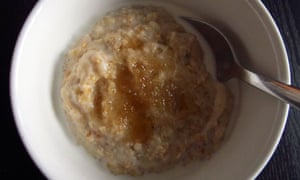
댓글
댓글 쓰기